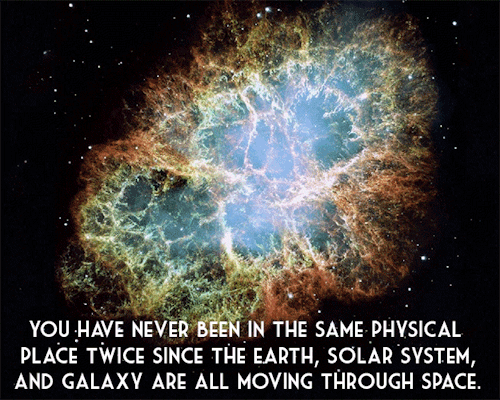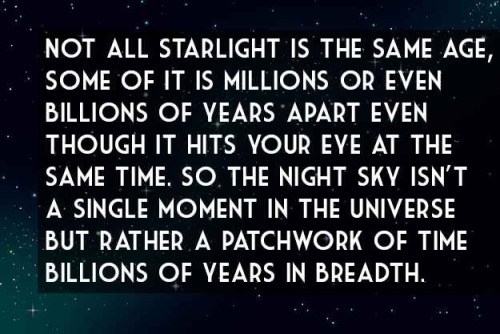The Gender Divide In Science Is Cultural Rather Than Anything To Do With Women’s Brains And Some Countries

The gender divide in science is cultural rather than anything to do with women’s brains and some countries do much better than others, she says.
In astrophysics southern European countries like France, Spain and Italy do much better than northern European countries like Germany and The Netherlands, for instance.
“In all those countries the proportion of women is going up but the pattern has stayed the same, which is interesting,” she says.
“The progress is slow, things are changing gradually.”
Her advice to women in science? “Don’t be daunted, hang in there, work hard, of course, be courageous.”
More Posts from Study-astronomy-biology-ref and Others
What would happen if two galaxies or black holes became one?
Hi there!
Astronomers have had the opportunity to observe galaxies colliding so they have been able to learn more about them!
In a galaxy collision, although quite violent, nothing usually happens to the stars or any solar systems! This is due to the vast spaces between stars. Usually the friction and gravitational interactions between the galaxies is what makes it violent. Our very own Milky Way galaxy is on collision course for the Andromeda Galaxy. It’s predicted that nothing will happen to our solar system, that we will just be flung into another part of the galaxy!
Black holes on the other hand are much more violent. Astronomers haven’t actually witnessed black holes colliding, but through computer simulations they’ve been able to simulate it!
The collision begins once they come too close to each other to escape each other’s gravity. Once that happens they’ll spiral towards each other until they eventually collide. Since it’s so violent they actually send ripples into space time!
Hope that helped! If not, feel free to ask me anything else :) xx
Stellar Outburst Brings Water Snow Line Into View
ESO - European Southern Observatory logo. 13 July 2016
Artist’s impression of the water snowline around the young star V883 Orionis
The Atacama Large Millimeter/submillimeter Array (ALMA) has made the first ever resolved observation of a water snow line within a protoplanetary disc. This line marks where the temperature in the disc surrounding a young star drops sufficiently low for snow to form. A dramatic increase in the brightness of the young star V883 Orionis flash heated the inner portion of the disc, pushing the water snow line out to a far greater distance than is normal for a protostar, and making it possible to observe it for the first time. The results are published in the journal Nature on 14 July 2016.
ALMA image of the protoplanetary disc around V883 Orionis
Young stars are often surrounded by dense, rotating discs of gas and dust, known as protoplanetary discs, from which planets are born. The heat from a typical young solar-type star means that the water within a protoplanetary disc is gaseous up to distances of around 3 au from the star [1] — less than 3 times the average distance between the Earth and the Sun — or around 450 million kilometres [2]. Further out, due to the extremely low pressure, the water molecules transition directly from a gaseous state to form a patina of ice on dust grains and other particles. The region in the protoplanetary disc where water transitions between the gas and solid phases is known as the water snow line [3].
The star V883 Orionis in the constellation of Orion
But the star V883 Orionis is unusual. A dramatic increase in its brightness has pushed the water snow line out to a distance of around 40 au (about 6 billion kilometres or roughly the size of the orbit of the dwarf planet Pluto in our Solar System). This huge increase, combined with the resolution of ALMA at long baselines [4], has allowed a team led by Lucas Cieza (Millennium ALMA Disk Nucleus and Universidad Diego Portales, Santiago, Chile) to make the first ever resolved observations of a water snow line in a protoplanetary disc.
Shifting water snowline in V883 Orionis
The sudden brightening that V883 Orionis experienced is an example of what occurs when large amounts of material from the disc surrounding a young star fall onto its surface. V883 Orionis is only 30% more massive than the Sun, but thanks to the outburst it is experiencing, it is currently a staggering 400 times more luminous — and much hotter [5].
ALMA image of the protoplanetary disc around V883 Orionis (annotated)
Lead author Lucas Cieza explains: “The ALMA observations came as a surprise to us. Our observations were designed to look for disc fragmentation leading to planet formation. We saw none of that; instead, we found what looks like a ring at 40 au. This illustrates well the transformational power of ALMA, which delivers exciting results even if they are not the ones we were looking for.”
ALMA image of the protoplanetary disc around V883 Orionis
The bizarre idea of snow orbiting in space is fundamental to planet formation. The presence of water ice regulates the efficiency of the coagulation of dust grains — the first step in planet formation. Within the snow line, where water is vapourised, smaller, rocky planets like our own are believed to form. Outside the water snow line, the presence of water ice allows the rapid formation of cosmic snowballs, which eventually go on to form massive gaseous planets such as Jupiter.
Zooming on the protoplanetary disc around V883 Orionis
The discovery that these outbursts may blast the water snow line to about 10 times its typical radius is very significant for the development of good planetary formation models. Such outbursts are believed to be a stage in the evolution of most planetary systems, so this may be the first observation of a common occurrence. In that case, this observation from ALMA could contribute significantly to a better understanding of how planets throughout the Universe formed and evolved.
The protoplanetary disc around V883 Orionis (artist’s impression)
Notes: [1] 1 au, or one astronomical unit, is the mean distance between the Earth and the Sun, around 149.6 million kilometres.This unit is typically used to describe distances measured within the Solar System and planetary systems around other stars. [2] This line was between the orbits of Mars and Jupiter during the formation of the Solar System, hence the rocky planets Mercury, Venus, Earth and Mars formed within the line, and the gaseous planets Jupiter, Saturn, Uranus and Neptune formed outside. [3] The snow lines for other molecules, such as carbon monoxide and methane, have been observed previously with ALMA, at distances of greater than 30 au from the protostar within other protoplanetary discs. Water freezes at a relatively high temperature and this means that the water snow line is usually much too close to the protostar to observe directly. [4] Resolution is the ability to discern that objects are separate. To the human eye, several bright torches at a distance would seem like a single glowing spot, and only at closer quarters would each torch be distinguishable. The same principle applies to telescopes, and these new observations have exploited the exquisite resolution of ALMA in its long baseline modes. The resolution of ALMA at the distance of V883 Orionis is about 12 au — enough to resolve the water snow line at 40 au in this outbursting system, but not for a typical young star. [5] Stars like V883 Orionis are classed as FU Orionis stars, after the original star that was found to have this behaviour. The outbursts may last for hundreds of years. More information: This research was presented in a paper entitled “Imaging the water snow-line during a protostellar outburst”, by L. Cieza et al., to appear in Nature on 14 July 2016. The team is composed of Lucas A. Cieza (Millennium ALMA Disk Nucleus; Universidad Diego Portales, Santiago, Chile), Simon Casassus (Universidad de Chile, Santiago, Chile), John Tobin (Leiden Observatory, Leiden University, The Netherlands), Steven Bos (Leiden Observatory, Leiden University, The Netherlands), Jonathan P. Williams (University of Hawaii at Manoa, Honolulu, Hawai`i, USA), Sebastian Perez (Universidad de Chile, Santiago, Chile), Zhaohuan Zhu (Princeton University, Princeton, New Jersey, USA), Claudio Cáceres (Universidad Valparaiso, Valparaiso, Chile), Hector Canovas (Universidad Valparaiso, Valparaiso, Chile), Michael M. Dunham (Harvard-Smithsonian Center for Astrophysics, Cambridge, Massachusetts, USA), Antonio Hales (Joint ALMA Observatory, Santiago, Chile), Jose L. Prieto (Universidad Diego Portales, Santiago, Chile), David A. Principe (Universidad Diego Portales, Santiago, Chile), Matthias R. Schreiber (Universidad Valparaiso, Valparaiso, Chile), Dary Ruiz-Rodriguez (Australian National University, Mount Stromlo Observatory, Canberra, Australia) and Alice Zurlo (Universidad Diego Portales & Universidad de Chile, Santiago, Chile). The Atacama Large Millimeter/submillimeter Array (ALMA), an international astronomy facility, is a partnership of ESO, the U.S. National Science Foundation (NSF) and the National Institutes of Natural Sciences (NINS) of Japan in cooperation with the Republic of Chile. ALMA is funded by ESO on behalf of its Member States, by NSF in cooperation with the National Research Council of Canada (NRC) and the National Science Council of Taiwan (NSC) and by NINS in cooperation with the Academia Sinica (AS) in Taiwan and the Korea Astronomy and Space Science Institute (KASI). ALMA construction and operations are led by ESO on behalf of its Member States; by the National Radio Astronomy Observatory (NRAO), managed by Associated Universities, Inc. (AUI), on behalf of North America; and by the National Astronomical Observatory of Japan (NAOJ) on behalf of East Asia. The Joint ALMA Observatory (JAO) provides the unified leadership and management of the construction, commissioning and operation of ALMA. ESO is the foremost intergovernmental astronomy organisation in Europe and the world’s most productive ground-based astronomical observatory by far. It is supported by 16 countries: Austria, Belgium, Brazil, the Czech Republic, Denmark, France, Finland, Germany, Italy, the Netherlands, Poland, Portugal, Spain, Sweden, Switzerland and the United Kingdom, along with the host state of Chile. ESO carries out an ambitious programme focused on the design, construction and operation of powerful ground-based observing facilities enabling astronomers to make important scientific discoveries. ESO also plays a leading role in promoting and organising cooperation in astronomical research. ESO operates three unique world-class observing sites in Chile: La Silla, Paranal and Chajnantor. At Paranal, ESO operates the Very Large Telescope, the world’s most advanced visible-light astronomical observatory and two survey telescopes. VISTA works in the infrared and is the world’s largest survey telescope and the VLT Survey Telescope is the largest telescope designed to exclusively survey the skies in visible light. ESO is a major partner in ALMA, the largest astronomical project in existence. And on Cerro Armazones, close to Paranal, ESO is building the 39-metre European Extremely Large Telescope, the E-ELT, which will become “the world’s biggest eye on the sky”. Links: Research paper: http://www.eso.org/public/archives/releases/sciencepapers/eso1626/eso1626a.pdf Photos of ALMA: http://www.eso.org/public/images/archive/search/?adv=&subject_name=Atacama%20Large%20Millimeter/submillimeter%20Array For more information about ALMA, visit: https://www.eso.org/sci/facilities/alma.html Images, Text, Credits: ESO/Richard Hook/A. Angelich (NRAO/AUI/NSF)/ALMA (ESO/NAOJ/NRAO)/ALMA//L. Cieza/IAU and Sky & Telescope/Videos: ALMA (ESO/NAOJ/NRAO)/L. Cieza./ESO/Digitized Sky Survey 2/N. Risinger (skysurvey.org)/M. Kornmesser. Music: Johan B. Monell. Best regards, Orbiter.ch Full article
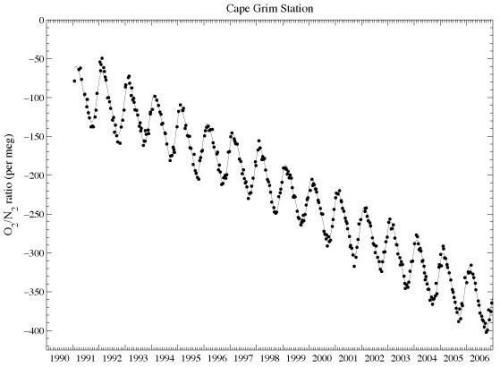
AIR!
Earth’s atmosphere recently crossed 400 ppm CO2 for the first time in millions of years and probably will not go back below that amount during any of our lifetimes. (http://tinyurl.com/bus4xpt). But did you know there’s something else changing in the atmosphere to go along with that CO2 rise?
It’s pictured in this graph. This gas is going down, decreasing in the atmosphere as CO2 goes up. That gas? Oxygen. Oxygen in the atmosphere is decreasing.
Be honest…did you just stop and take a deep breath? It really is kinda creepy to realize that the gas everyone is taught as a kid they need to survive is going down in the atmosphere.
Anyway, why is oxygen going down? The same reason that carbon is going up; burning of fossil fuels.
Keep reading









Cosmic Web
The concept of the cosmic web—viewing the universe as a set of discrete galaxies held together by gravity—is deeply ingrained in cosmology. Yet, little is known about architecture of this network or its characteristics. Our research used data from 24,000 galaxies to construct multiple models of the cosmic web, offering complex blueprints for how galaxies fit together. These three interactive visualizations help us imagine the cosmic web, show us differences between the models, and give us insight into the fundamental structure of the universe.
An awesome work of the Center for Complex Network Research
Wow this is really cool! Love the amount of efforts put into this!
Animal/Bio-Diversity Facts!
I combined these two topics because there’s a lot of overlap, and I decided that taking notes on both really helped me understand what the other is trying to say. This will be a long post, strap yourself in.
Organisms are organized and classified via a system known as Taxonomy. This system was developed by a scientist named Carl Linnaeus. To identify individual organisms, binomial nomenclature is used. What this means is each organism is called by their genus and species name. For example, Homo sapien, Pyrrhura molinae, (Green cheek conure), and Betta splendens.
There were originally 6 taxa or levels of organization developed by Linnaeus; kingdom, phylum, class, order, family, genus, and species. The 20th century saw many changes to Linnaeus’ original system of organization. The 3 original kingdoms were expanded to 5; Monera, Protista, Fungi, Plantae, and Animalia, a 6th, Archaebacteria was added to represent extremophiles that were so intense they had to be separated from bacteria to give their coolness more merit.
Today’s scientists added a 7th level, domain. We use a 3-domain system based on DNA analysis. These domains are eukarya, bacteria, and archaea. Monera stopped being used as the prokaryotes were split between bacteria and archaea. Archaea are in fact, not bacteria, and so were given their own domain.

Here are some characteristics shared among members of the same domain:
Bacteria
All members of this domain are unicellular prokaryotes. This means that they lack internal membranes, like a nucleus, mitochondria, or chloroplasts)
Some are anaerobic (metabolize without oxygen) some are aerobic (metabolize with oxygen)
In the environment, some are decomposers, meaning they decompose and recycle dead organic material.
Some are pathogens, such as some strains of E.coli.
Speaking of E.coli, they also play a vital role in genetic engineering. E.coli is used to manufacture human insulin
Some reproduce using conjugation. This is a primitive process, where individuals exchange genetic material
They have a thick and rigid cell wall
Some, like blue-green algae, are autotrophic (make their own food) others are heterotropic (depend on complex organic substances for food)
Have no introns (noncoding segments of DNA)
Archaea
Also unicellular prokaryotes
Include extremophiles, which are organisms that live in extreme environments. Some examples are Methanogens (obtain energy by producing methane from hydrogen) Halophiles (thrive in extremely salty environments, such as the Dead Sea) and Thermophiles (thrive in extremely high temperatures, like Yellowstone’s hot springs)
Have introns present in some of their genes
Eukarya
Have a nucleus and internal, membrane-bound organelles
Include: Protista, Fungi, Plantae, and Animalia
Moving into kingdoms, there are 4. These are the 4 mentioned above, fungi, Protista, Plantae, and Animalia. Here are some traits for each:
Protista
Most are unicellular, however, some are primitive multicellular organisms.
Include both heterotrophs (like amoeba, and paramecium) and autotrophs (like euglenas)
Move using different structures, such as pseudopods in amoeba, cilia in paramecium, and flagella in euglenas.
Include organisms not cool enough to sit with the fungi or Plantae kingdoms, like seaweed and slime mould.
Some, like algae and paramecium, carry out conjugation
Some can cause serious diseases like amoebic dysentery and malaria
Fungi
All are heterotrophic
Include unicellular and multicellular organisms
Able to digest extracellularly by secreting hydrolytic enzymes, and absorbing the nutrients via diffusion.
Are essential to the environment, as they are decomposers. They are saprobes, which mean they eat decaying organic matter.
They have cell walls, however, unlike plants whose cell walls are made of cellulose, their cell walls are made of chitin.
Lichens are fungi and algae living in a mutualistic, symbiotic relationship. Lichens are strong enough to withstand harsh, unforgiving environments, thus are often the pioneer organisms (the first to colonize a new environment).
They reproduce asexually by budding, like yeast, spore formation, like bread mould, or fragmentation (aka 1 parent breaks itself into several, living pieces), however, some can reproduce sexually.
Plantae
All are multicellular, nonmotile, and autotrophic.
Their cell walls, as mentioned above, are made of cellulose.
Plants can create their own food by photosynthesis, which uses chlorophyll a and b.
Their carbohydrates are stored as starch
They reproduce sexually by alternating between the gametophyte and sporophyte generations.
Some (tracheophytes) have vascular tissue while others (bryophytes) do not.
Animalia
All are heterotrophic, multicellular, and motile
Most reproduce sexually with a dominant diploid (2n) stage
In most, a sperm with a flagellum fertilizes a large, nonmotile egg.
Animals are classified, traditionally based on anatomical features (homologous structures) and embryonic development.
There are 35 phyla. Since I want to eat something today, I’ll go over the 9 the Barron’s SAT book describes, which are Porifera, cnidarians, Platyhelminthes, nematodes, annelids, molluscs, arthropods, echinoderms, and chordates.
Each animal phylum represents the evolution of a new, successful body plan. Some of these trends include specialisation of tissues, germ layers, body symmetry, the development of a head end, and body cavity formation.
Specialized cells, tissues, and organs
The cell is the basic unit of all life, for example, fat cells. Tissue is the next block up and is a collection of tissues performing a function, such as adipose tissue. An organ is a group of tissues working together to perform a similar function. For example, the brain.
Organisms making up the phylum Porifera, like sponges are made of a loose confederation of cells. Since those cells are not specialized, they are not considered tissue. These cells can react to stimuli, however, lack muscle or nerve tissue.
Organisms making up the phylum cnidaria possess tissue, however the most primitive and simple form of tissue. However, no organs. Flatworms do have organs, however, lack an organ system. Annelids, however, possess a full organ system.
Germ Layers
Germ layers make up the tissues and organs of the body. They form early in embryonic development. There are 3 kinds, however, not all organisms have all 3.
Ectoderm- outermost layer, makes up skin and nervous system
Mesoderm- middle layer, becomes blood, muscles, and bones
Endoderm- innermost layer, makes up the viscera (guts)
Porifera and cnidarians only have 2 layers. They lack mesoderm and instead have mesoglea or middle glue which holds the 2 layers together. Organisms that have 3 true germ layers are called triploblastic.
Body Symmetry
Most primitive animals exhibit radial symmetry. More complex animals exhibit bilateral symmetry. This is displayed in the drawings below. Echinoderms are a key exception to this rule. They develop with bilateral symmetry, however, as an adult, they exhibit radial symmetry. In bilateral symmetry, the body mirrors itself along the left and right on the longitudinal axis.

This also means that Patrick Star is not drawn biologically accurate. Shame.
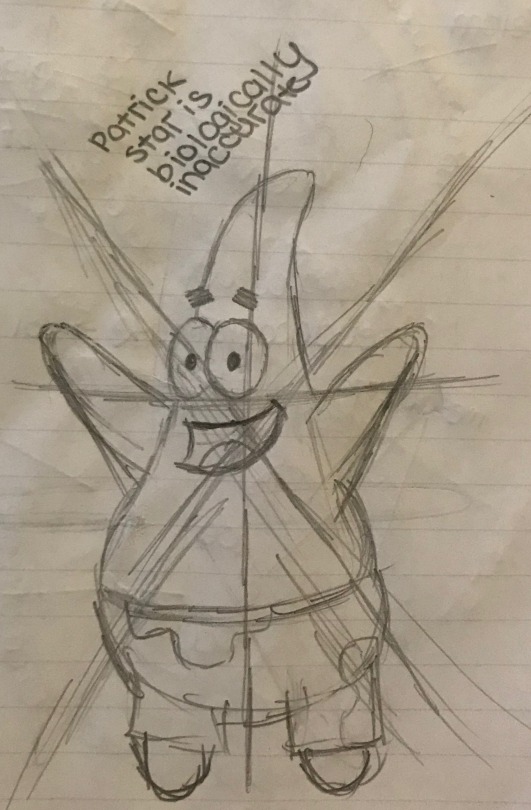
Body Cavity Formation
The coelom is a fluid-filled body cavity, completely surrounded by mesoderm tissue. It is found only in more evolutionarily advanced organisms. Organisms like flatworms, who lack a coelom are known as acoelomates. Organisms, like nematodes or roundworms, who have a fluid-filled tube between the endoderm and mesoderm, functioning as a hydrostatic skeleton, are known as pseudocoelomates. Coelomates are organisms with a true coelom. Annelida, Mollusca, Arthropoda, and Chordata are all phyla that have this structure.

Development of a Head (Cephilization)
Organisms that developed bilateral symmetry also have an anterior and posterior end. (The head and rear end). The sensory apparatus and brain, or ganglia in less developed organisms are organized on the anterior end, while digestion, excretion, and reproduction all keep their organs on the posterior end. Cephilization began with flatworms.
Here is a cladogram to help visualize when different traits developed.

Traits of 9 different phyla:
Porifera:
No symmetry at all
No nerve or muscle tissue, sessile (nonmotile)
Filter nutrients from water drawn into a central cavity
Like many other primitive organisms, they only have 2 cell layers, ectoderm and endoderm, with the noncellular mesoglea holding them together
They have specialized cells, however, there is no organization to the cells, therefore they do not have tissue or organs.
Evolved from colonial organisms: fun fact, you can push a sponge through a cheesecloth, which will separate into individual cells, all and become a sponge. This is related to how a sponge reproduces
They reproduce asexually via fragmentation, meaning each piece that is separated has the necessary cells to become an individual organism. This means that technically,

Spongebob is reproducing here. Good on him.
They also reproduce sexually. They are hermaphrodites, meaning that they have characteristics of both males and females.
Cnidarians
Include organisms like hydra and jellyfish
Radial symmetry
Body plan is a polyp (vase-shaped, like hydra) which is mostly sessile or medusa (upside-down bowl-shaped, like jellyfish) which is mostly motile.
Life cycle- although there are exceptions, some go through a planula larva (free-swimming) stage, then proceed to their reproductive stage, that being asexual (polyps, ) or sexual (medusas)
Only have ectoderm and endoderm cell layers
Have a gastrovascular cavity where extracellular digestion occurs. They only have one opening to this cavity, so waste and food both go through the mouth.
Have lysosomes where intracellular digestion occurs.
No transport system, since each cell is in contact with the outside environment.
All have stinging cells (cnidocytes) for protection, with nematocysts, which are stingers.
Platyhelminthes
Include organisms like flatworms like tapeworms
These are the most simple organisms with bilateral symmetry, an anterior end, and 3 distinct cell layers (ectoderm, endoderm, and mesoderm… yay bones muscle and blood!)
The digestive cavity has only 1 opening for egestion and ingestion, like cnidaria, so food can’t be continuously processed.
Their body is solid and has no room for a true digestive and respiratory system to circulate food or oxygen. The solution to this problem was to develop an extremely flat and thin body that allowed most of their body cells to have contact with the outside and thus exchange nutrients and waste via diffusion.
Nematodes
Include roundworms like pinworms
Unsegmented worms with bilateral symmetry, but very little sensory apparatus.
A large majority of them are parasitic. Trichinosis is caused by the worm Trichinella, which is often found in uncooked pork.
C. elegans is often used as an animal model when studying genes and embryonic development.
Digestive tract is two way, meaning they have a mouth and an anus
Annelids
Include earthworms and leeches
Segmented worms with bilateral symmetry, and very little sensory apparatus.
Two-way digestive tract, and a tube within a tube, consisting of a crop, gizzard, and intestine.
They have a nephridium, which is a tubule responsible for the excretion of nitrogen waste, urea.
They have a closed circulatory system and a heart with 5 pairs of aortic arches
Diffuse oxygen and carbon dioxide through their moist skin
Hermaphrodites
Mollusca
Include squids, octopi, slugs, clams and snails.
Have soft bodies, protected by hard calcium shells
They have open circulatory systems. This means they don’t have capillaries, however, have blood-filled spaces called hemocoels, or sinuses.
Have bilateral symmetry and 3 distinct body zones: The head-foot, with sensory and motor organs, Visceral mass, with organs of digestion, excretion, and reproduction, and the mantle, a specialized tissue that surrounds the visceral mass and produces the shell.
They have something known as a radula, which is moveable and has teeth, that behaves like a tongue.
Many have gills and nephridia
Arthropods
Include insecta (like grasshoppers), crustacea (like shrimp and crabs), and arachnida (like spiders and scorpions
Have jointed appendages
Segmented into head, thorax, and abdomen
Contain more sensory apparatuses than annelids which means they can move much more freely
Have an exoskeleton made of a polysaccharide known as chitin.
They also have an open circulatory system, with a tubular hard and hemocoels
For excretion, they have structures known as Malpighian tubules, which remove the nitrogenous waste; uric acid.
They have air ducts known as trachea which bring air from the environment into hemocoels.
Echinoderms
Include sea stars and sea urchins.
Most are sessile, or slow-moving (so stop judging Patrick. It’s just how he was born)
They are an exception to the bilateral symmetry rule. As embryos, they have bilateral symmetry, however, as they develop, they develop radial symmetry. This evolved for their sedentary lifestyle.
They have a water vascular system, which creates hydrostatic support for their tube feet which allow for locomotion
They reproduce sexually via external fertilization
They also have the ability to reproduce asexually via fragmentation, and regeneration. As long as the new sea star has part of the central canal, it will become a new organism.
They have an endoskeleton with calcium plates. Endoskeletons grow with the body, as opposed to exoskeletons that have to be shed
Chordates
Include vertebrae (like us!)
Chordates have a notochord which is a rod that extends the length of the body and is a flexible axis.
They have a dorsal, hollow nerve cord
The tail is responsible for movement and balance. We, humans, have a coccyx, which is a vestige of what was once our tail. Hence the name, tailbone.
Birds and mammals are homeotherms, meaning they are able to maintain consistent body temperature. The other chordates, like fish, reptiles, and amphibians are cold-blooded.
Let’s get specific, with mammals (because mammals are a superior class of animals. I would know, I am one.)
Mammals are named after their mammary glands. These glands let mothers provide milk to their babies.
They all have hair or fur
They are endotherms, meaning they generate their hair from within
Most are placental mammals, also known as eutherians. The embryo develops internally in a uterus connected to the mother via a placenta. Since the embryo is unable to perform essential functions such as digestion and excretion by itself, until late into the pregnancy, the placenta diffuses nutrients in and waste out for the baby.
Marsupials are an interesting class of animals. Their babies are born extremely early in development (after about 36 days), however, the mother has a pouch, where the baby will nurse until around 9 months.
Most mammals give birth to live young. There are exceptions to this rule, as our favourite egg-laying mammal of action’s theme explained to us. (Dooby dooby dooa dooby dooby dooaa AGENT P!)
Platypi and spiny anteaters derive their nutrients from a shelled egg.

Getting even more specific, let’s talk about primates. These are the least superior mammals. I should know. I am one.
Primates were descendants of insectivores. They have dexterous hands, and opposable thumbs, which allow their hands to perform fine motor tasks. Instead of claws, they have nails
Their hands contain many nerve endings, making them very sensitive (which is why papercuts are so agonizingly painful.) Their eyes are forward-facing and close together. This allows face to face communication. Close eyes allow for overlapping fields of vision, increasing depth perception and hand-eye coordination.)
Primates engage in the most intensive parenting out of any mammal. They tend to have single births and build strong bonds with their young.
The book organized 3 different organisms based on their taxonomy. I put that down and added rats because rats are cool. Don’t @ me.

Cladograms
Cladograms are an extremely useful tool to show how organisms evolved different traits over time. There is a more complicated one above, however, the book included an extremely simplified one also that helped me understand how these graphs are made, so I will include that here as well.
First, like any graph, a table is made detailing the data that will be graphed. In this case, this data will be the specific organisms (cats, lizards, salmons, and earthworms) and the existence of specific traits (backbone, legs, and hair.)
Then a line is drawn, showing each trait as it developed, following by the organism with that trait.

What this graph shows is that cats and lizards are more related than lizards and earthworms, etc. Tldr; a cladogram/phylogenetic tree draws distinctions between shared traits (traits different organisms have in common) and derived traits (traits that the ancestor did not have) displayed in such a way so as to show the evolutionary history of a group of organisms.
So what qualifies an animal? Animals are multicellular eukaryotes. They are all heterotrophs, meaning they acquire nutrients via ingestion. (Unlike plants, which manage to get nutrients through photosynthesis, such as the Calvin Cycle which produces a plants sugar.) All animals can move in some form.
Movement is a broad term. Beating cilia, and waving tentacles both count as movement. The movement that often comes to peoples minds, however, is locomotion, which is the movement from place to place. Some animals are sessile, which means they lack the capability to move from place to place. Hydra can still wave their tentacles (in the air like they just don’t care). Sponges are an interesting case, as many legitimately, cannot move.
Above, I mentioned terms like endoskeletons, exoskeletons, and hydrostatic skeletons. Hydrostatic skeletons are closed body compartments filled with fluid, that provide support. Exoskeletons are external, nongrowing skeletons, made of chitin (which also makes up the cell walls of fungi). Endoskeletons are internal skeletons made of bone and cartilage that grow with the organism. They are connected to each other at joints via ligaments, and to skeletal muscles (voluntary muscles) via the tendons.
All life has the ability to maintain homeostasis. Life survives within a narrow temperature range, from around 0 degrees Celsius to around 50 degrees celsius. In the ocean, this was not a massive problem, as it is the most stable environment temperature-wise, as water is able to absorb a lot of heat. However, the land is a lot more crazy. Different organisms found different ways to adapt and survive.
For example, a jackrabbit’s ears are a major tell about what climate they live in. Jackrabbits that survive in the cold have small ears to minimize heat loss. Jackrabbits living in the heat have large ears that allow heat to dissipate, filled with small capillaries making the ears appear pink.
Huddling, basking, panting and sweating, swarming, and shivering are all examples of adaptations different organisms use to survive in extreme temperature. Depending on whether an organism is an ectotherm or endotherm, their temperature regulation will be different. An ectotherm is heated from the outside. For example, crocodiles bask in the warm sun to heat their bodies up. Endotherms or homeotherms generate their heat from the inside by using large quantities of energy. For example, a litter of cold puppies will huddle together and with their mother, as their warmth, and their mothers warmth help heat them up.
Excretion refers to the removal of metabolic waste, such as excess water, carbon dioxide, and nitrogenous waste. There are 3 different kinds produced by different organisms
Ammonia
Ammonia is soluble in water and extremely toxic. Anybody who takes proper care of a fish tank is aware that cleaning the ammonia from their tank is essential in keeping their fish healthy.
Excreted mainly by marine life, like hydra and fish.
Urea
Not as toxic as ammonia
Excreted by earthworms and humans (urine contains urea and water)
In mammals, the liver is responsible for turning ammonia into urea.
Uric Acid
A paste-like substance that isn’t soluble, and not very toxic
Excreted by insects, many reptiles, and birds, and allow for the preservation of water.
Different organisms have different structures that allow for excretion.
Hydra excretes ammonia with no aid from any excess structure.
Platyhelminthes have flame cells that help them excrete ammonia
Earthworms have nephridia (metanephridia) to excrete Urea
Insects have Malpighian tubules to excrete uric acid
Humans have nephrons to excrete urea.
Following up, let’s look at 3 different organisms and the characteristics that make them unique!
Hydra (from Cnidaria)
Hyrda digest their food in the gastrovascular cavity. They, unfortunately only have one hole, where food goes in and waste comes out. The gastrodermis (gastrovascular cavity lining, or gastrocoel) secrete digestive enzymes to help extracellular digestion progress. Lysosomes, which are found in animal cells are responsible for intracellular digestion.

Hydra reproduces asexually by budding. A bud is a genetically identical, but tiny little hydra that grows within or on the parent.
Earthworms (From Annelida)
The digestive system of earthworms is much more complex than that of the hydra. Luckily, they have a mouth and an anus. The mouth ingests decaying organic matter along with the soil. The food travels down the oesophagus into the crop. The crop stores the food until it is ready to be digested. The food then moves into the gizzard, with thick muscular walls that digest the food mechanically, with the aid of the ingested sand and soil. The food moves into the intestines, where chemical digestion occurs. The intestine has a large fold, called the typhlosole, which increases the surface area.

Worms don’t have a traditional respiratory system. Instead, gas is exchanged by diffusion, through moist skin. This type of respiratory system is called an external respiratory system. Their hearts have 5 aortic arches that pump blood. Worms have capillaries, giving them a closed circulatory system. Their blood contains haemoglobin, making it red. Earthworms have nephridia, excreting urea, and are hermaphrodites. A worms brain is made of two dorsal, solid, fused ganglia, with a solid, ventral, nerve cord.
Grasshoppers (From Arthropoda)
Grasshoppers also have a digestive tract consisting of a crop and gizzard. They also have mouthparts specialized for tasting, biting, and crushing food, and their gizzard has chitin plates that aid in mechanical digestion. Their digestive tract contains Malpighian tubules that remove nitrogenous waste in the form of uric acid. (No, I did not draw a grasshopper. I know when I am defeated.)
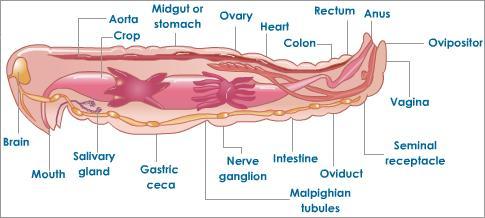
Grasshoppers have a similar nervous system to worms, however, they have an open circulatory system. They lack capillaries, and blood moves through hemocoels instead. Arthropod blood has no haemoglobin. They have an internal respiratory surface because gas exchange occurs on the inside. They have a system of tracheal tubes that lead to the hemocoels. Oxygen is carried by hemocyanin, with copper as the core atom. This is why molluscs and insects have blue blood.

Some galaxies have extremely bright cores, suggesting that they contain a supermassive black hole that is pulling in matter at a prodigious rate. Astronomers call these “active galaxies,” and Hercules A is one of them. In visible light, Hercules A looks like a typical elliptical galaxy. In X-ray light, however, Chandra detects a giant cloud of multimillion-degree gas (purple). This gas has been heated by energy generated by the infall of matter into a black hole at the center of Hercules A that is over 1,000 times as massive as the one in the middle of the Milky Way. Radio data (blue) show jets of particles streaming away from the black hole. The jets span a length of almost one million light years.
Credit: X-ray: NASA/CXC/SAO, Optical: NASA/STScI, Radio: NSF/NRAO/VLA


Gliese 832c: is a Potentially Habitable Super-Earth Discovered only 16 Light-Years from Earth
A team of astronomers led by Dr Robert Wittenmyer of the University of New South Wales have discovered the super-Earth. The newly discovered exoplanet, labeled Gliese 832c, has an orbital period of 35.68 days, a mass 5.4 times that of Earth’s and receives about the same average energy as Earth does from the Sun. Gliese 832c might have Earth-like temperatures, giving it a similar terrestrial atmosphere. If the planet has a similar atmosphere to Earth it may be possible for life to survive, although seasonal shifts would be extrem.
Gliese 832c was discovered from its gravitational pull on its star, which causes the star to wobble slightly.
-
 masonnerd liked this · 4 years ago
masonnerd liked this · 4 years ago -
 casantoninawasiluk liked this · 5 years ago
casantoninawasiluk liked this · 5 years ago -
 le-sorceri liked this · 5 years ago
le-sorceri liked this · 5 years ago -
 laetussum reblogged this · 5 years ago
laetussum reblogged this · 5 years ago -
 astromelomaniac liked this · 5 years ago
astromelomaniac liked this · 5 years ago -
 sereiaxz liked this · 5 years ago
sereiaxz liked this · 5 years ago -
 epicchameleon liked this · 5 years ago
epicchameleon liked this · 5 years ago -
 1society1 reblogged this · 5 years ago
1society1 reblogged this · 5 years ago -
 salutarymango liked this · 5 years ago
salutarymango liked this · 5 years ago -
 nighthawkslair liked this · 5 years ago
nighthawkslair liked this · 5 years ago -
 tillsunbeamsfindyou reblogged this · 5 years ago
tillsunbeamsfindyou reblogged this · 5 years ago -
 queerorwhat liked this · 5 years ago
queerorwhat liked this · 5 years ago -
 pitchsilent liked this · 5 years ago
pitchsilent liked this · 5 years ago -
 study-astronomy-biology-ref reblogged this · 5 years ago
study-astronomy-biology-ref reblogged this · 5 years ago -
 the42ndcynicalreader liked this · 5 years ago
the42ndcynicalreader liked this · 5 years ago -
 issienizzy reblogged this · 5 years ago
issienizzy reblogged this · 5 years ago -
 annabreaksthings reblogged this · 5 years ago
annabreaksthings reblogged this · 5 years ago -
 doctordonnadances reblogged this · 5 years ago
doctordonnadances reblogged this · 5 years ago -
 rottingskin liked this · 5 years ago
rottingskin liked this · 5 years ago -
 howtotrainyouragents reblogged this · 5 years ago
howtotrainyouragents reblogged this · 5 years ago -
 asmallbluedinosaurnamed-chonk reblogged this · 5 years ago
asmallbluedinosaurnamed-chonk reblogged this · 5 years ago -
 asmallbluedinosaurnamed-chonk liked this · 5 years ago
asmallbluedinosaurnamed-chonk liked this · 5 years ago -
 nbryan5 liked this · 5 years ago
nbryan5 liked this · 5 years ago -
 desertinn liked this · 5 years ago
desertinn liked this · 5 years ago -
 enchantingsheepcollector liked this · 5 years ago
enchantingsheepcollector liked this · 5 years ago -
 moirinx reblogged this · 5 years ago
moirinx reblogged this · 5 years ago -
 moirinx liked this · 5 years ago
moirinx liked this · 5 years ago -
 nevermindmoonshine reblogged this · 5 years ago
nevermindmoonshine reblogged this · 5 years ago -
 drzell liked this · 5 years ago
drzell liked this · 5 years ago -
 kurtmn liked this · 5 years ago
kurtmn liked this · 5 years ago -
 whoareurl liked this · 5 years ago
whoareurl liked this · 5 years ago -
 celticmoonstone liked this · 5 years ago
celticmoonstone liked this · 5 years ago -
 3rdbogwitch2theleft liked this · 5 years ago
3rdbogwitch2theleft liked this · 5 years ago -
 cyclicprogression reblogged this · 5 years ago
cyclicprogression reblogged this · 5 years ago -
 mizzmagnet liked this · 5 years ago
mizzmagnet liked this · 5 years ago -
 picayoon liked this · 5 years ago
picayoon liked this · 5 years ago -
 first-potato-in-spaace liked this · 5 years ago
first-potato-in-spaace liked this · 5 years ago -
 tangent101 reblogged this · 5 years ago
tangent101 reblogged this · 5 years ago

This is a studyblr for everyone have some passion for science, especially astronomy and biology
129 posts







